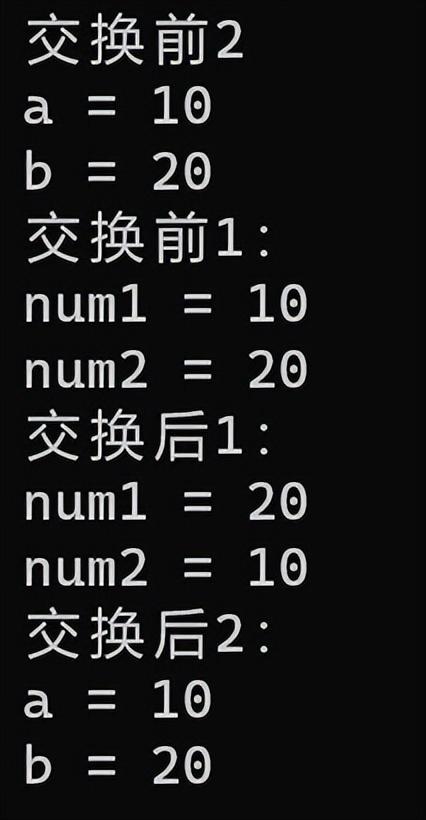C++编程:深入理解函数
发表时间: 2024-02-19 22:02
将一段经常使用的代码封装起来,减少重复代码
一个较大的程序,一般分为若干个程序块,每个模块实现特定的功能
函数定义步骤
语法:
int add(int num1, int num2) { int sum = num1 + num2; return sum; }功能:使用定义好的函数
#include<iostream> using namespace std; //num1,num2为形式参数 int add(int num1, int num2) { int sum = num1 + num2; return sum; } int main() { //main函数中调用add函数 int a = 10; int b = 20; //函数调用语法 函数名称(参数) int c = add(a, b); //a,b称为实际参数 cout << c << endl; return 0; }调用函数的时候,注意数据类型要一样
就是把实参的值给了形参,形参计算后在返回
就是实参的数给了形参
值传递时,如果形参发生改变,并不会影响实参
#include<iostream> using namespace std; void swap(int num1, int num2) { cout << "交换前1:" << endl; cout << "num1 = " << num1 << endl; cout << "num2 = " << num2 << endl; int temp = num1; num1 = num2; num2 = temp; cout << "交换后1:" << endl; cout << "num1 = " << num1 << endl; cout << "num2 = " << num2 << endl; } int main() { int a = 10; int b = 20; cout << "交换前2" << endl; cout << "a = " << a << endl; cout << "b = " << b << endl; swap(a, b); cout << "交换后2:" << endl; cout << "a = " << a << endl; cout << "b = " << b << endl; return 0; }
由于num1,num2(形参)发生了改变,导致a,b(实参)不会发生改变
无参无返:
#include<iostream> using namespace std; //无参无返 void test01() { cout << "this is test01" << endl; } int main() { //无参无返函数调用 test01(); return 0; }有参无返:
#include<iostream> using namespace std; //有参无返 void test02(int a) { cout << "this is test02 a = "<< a << endl; } int main() { //有参无返函数调用 test02(100); return 0; }输出结果:this is test02 a = 100
#include<iostream> using namespace std; void swap(int a, int b) { int temp = a; a = b; b = temp; cout << "a = "<< a << endl; cout << "b = "<< b << endl; } int main() { int a = 10; int b = 20; swap(a,b); return 0; }输出结果:
a = 20
b = 10
无参有返:
#include<iostream> using namespace std; //无参有返 int test03() { return 1000; } int main() { //调用无参有返函数 int num1 = test03(); cout << num1 << endl; return 0; }输出结果:1000
有参有返:
#include<iostream> using namespace std; //有参有返 int test04(int a) { cout << "this is test04 a = " << a << endl; return 2; } int main() { //调用有参有返函数 int num1 = test04(1); cout << "num1 = "<< num1 << endl; return 0; }输出结果:this is test04 a = 1 \n num1 = 2
解释:把1给函数test04,故a等于1,而test04函数的返回值是2,所以会返回2并赋值给num1,因此num1的值为2
#include<iostream> using namespace std; int max(int a, int b) { return a > b ? a : b; } int main() { int a = 10; int b = 20; cout << max(a, b) << endl; return 0; }一般来说把max函数放前面,然后是main函数,因为在main函数里要调用max函数,如果反过来则无法运行,不过可以先声明max函数
#include<iostream> using namespace std; int max(int a, int b);//函数的声明,提前告诉编译器函数max存在 int max(int a, int b);//可以声明多次,定义只能一次 int main() { int a = 10; int b = 20; cout << max(a, b) << endl; return 0; } int max(int a, int b) { return a > b ? a : b; }让代码变清晰
main源文件.cpp
#include<iostream> using namespace std; #include"swap.h"//主要的源文件加上这一行即可 int main() { int a = 10; int b = 20; swap(a,b); return 0; }swap.h
#include<iostream> using namespace std; void swap(int a, int b);//头文件声明swap.cpp
#include"swap.h"//源文件定义 void swap(int a, int b) { int temp = a; a = b; b = temp; cout << "a = " << a << endl; cout << "b = " << b << endl; }其实swap.h中的#include<iostream>和using namespace std;可以放在swap.cpp中